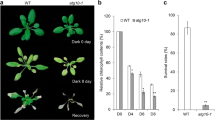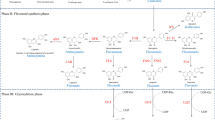Abstract
The effects of hexavalent chromium [Cr(VI)] on the cortical microtubules (MTs) of five species of the Fabaceae family (Vicia faba, Pisum sativum, Vigna sinensis, Vigna angularis, and Medicago sativa) were investigated by confocal laser scanning microscopy after immunolocalization of total tubulin with conventional immunofluorescence techniques and of acetylated α-tubulin with the specific 6-11B-1 monoclonal antibody. Moreover, total α-tubulin and acetylated α-tubulin were quantified by Western immunoblotting and scanning densitometry. Results showed the universality of Cr(VI) detrimental effects to cortical MTs, which proved to be a sensitive and reliable subcellular marker for monitoring Cr(VI) toxicity in plant cells. However, a species-specific response was recorded, and a correlation of MT disturbance with the acetylation status of α-tubulin was demonstrated. In V. faba, MTs were depolymerized at the gain of cytoplasmic tubulin background and displayed low α-tubulin acetylation, while in P. sativum, V. sinensis, V. angularis, and M. sativa, MTs became bundled and changed orientation from perpendicular to oblique or longitudinal. Bundled MTs were highly acetylated as determined by both immunofluorescence and Western immunoblotting. Tubulin acetylation in P. sativum and M. sativa preceded MT bundling; in V. sinensis it followed MT derangement, while in V. angularis the two phenomena coincided. Total α-tubulin remained constant in all treatments. Should acetylation be an indicator of MT stabilization, it is deduced that bundled MTs became stabilized, lost their dynamic properties, and were rendered inactive. Results of this report allow the conclusion that Cr(VI) toxicity disrupts MTs and deranges the MT-mediated functions either by depolymerizing or stabilizing them.










Similar content being viewed by others
References
Adamakis I-DS, Eleftheriou EP, Rost TL (2008) Effects of sodium tungstate on the ultrastructure and growth of pea (Pisum sativum) and cotton (Gossypium hirsutum) seedlings. Environ Exp Bot 63:416–425. doi:10.1016/j.envexpbot.2007.12.003
Adamakis I-DS, Panteris E, Eleftheriou EP (2010a) Tungsten affects the cortical microtubules of Pisum sativum root cells: experiments on tungsten–molybdenum antagonism. Plant Biol 12:114–124. doi:10.1111/j.1438-8677.2009.00197.x
Adamakis I-DS, Panteris E, Eleftheriou EP (2010b) The cortical microtubules are a universal target of tungsten toxicity among land plant taxa. J Biol Res (Thessaloniki) 13:59–66
Adamakis I-DS, Panteris E, Eleftheriou EP (2011) The fatal effect of tungsten on Pisum sativum L. root cells: indications for endoplasmic reticulum stress-induced programmed cell death. Planta 234:21–34. doi:10.1007/s00425-011-1372-5
Adamakis I-DS, Panteris E, Cherianidou A, Eleftheriou EP (2013) Effects of bisphenol A on the microtubule arrays of Pisum sativum L. root meristematic cells. Mutat Res Genet Toxicol Environ Mutagen 750:111–120. doi:10.1016/j.mrgentox.2012.10.012
Adamakis I-DS, Panteris E, Eleftheriou EP (2014) Tungsten disrupts root growth in Arabidopsis thaliana by PIN targeting. J Plant Physiol 171:1174–1187. doi:10.1016/j.jplph.2014.04.010
Anderson RA (1997) Chromium as an essential nutrient for humans. Regul Toxicol Pharmacol 26:835–841
Åström H (1992) Acetylated α-tubulin in the pollen tube microtubules. Cell Biol Int Rep 16:871–881
Baskin TI, Wilson JE, Cork A, Williamson RE (1994) Morphology and microtubule organization in Arabidopsis roots exposed to oryzalin or taxol. Plant Cell Physiol 35:935–942
Blancaflor EB, Jones DL, Gilroy S (1998) Alterations in the cytoskeleton accompany aluminum-induced growth inhibition and morphological changes in primary roots of maize. Plant Physiol 118:159–172
Degrassi F, Rizzoni M (1982) Micronucleus test in Vicia faba root tips to detect mutagen damage in fresh-water pollution. Mutat Res 97:19–23. doi:10.1016/0165-1161(82)90016-4
Dho S, Camusso W, Mucciarelli M, Fusconi A (2010) Arsenate toxicity on the apices of Pisum sativum L. seedling roots: effects on mitotic activity, chromatin integrity and microtubules. Environ Exp Bot 69:17–23. doi:10.1016/j.envexpbot.2010.02.010
Dovgalyuk A, Kalynyak T, Blume YB (2003) Heavy metals have a different action from aluminium in disrupting microtubules in Allium cepa meristematic cells. Cell Biol Int 27:193–195. doi:10.1016/S1065-6995(02)00334-7
Eleftheriou EP (1994) Abnormal structure of protophloem sieve-element cell wall in colchicine-treated roots of Triticum aestivum. Planta 193:266–274
Eleftheriou EP, Adamakis I-DS, Melissa P (2012) Effects of hexavalent chromium on microtubule organization, ER distribution and callose deposition in root tip cells of Allium cepa L. Protoplasma 249:401–416. doi:10.1007/s00709-011-0292-3
Eleftheriou EP, Adamakis I-DS, Fatsiou M, Panteris E (2013) Hexavalent chromium disrupts mitosis by stabilizing microtubules in Lens culinaris Moench. root tip cells. Physiol Plant 147:169–180. doi:10.1111/j.1399-3054.2012.01652.x
Eleftheriou EP, Michalopoulou VA, Adamakis I-DS (2015) Aberration of mitosis by hexavalent chromium in some Fabaceae members is mediated by species-specific microtubule disruption. Environ Sci Pollut Res. doi:10.1007/s11356-014-3880-x
Eun S-O, Youn HS, Lee Y (2000) Lead disturbs microtubule organization in the root meristem of Zea mays. Physiol Plant 110:356–365. doi:10.1111/j.1399-3054.2000.1100310.x
Frantzios G, Galatis B, Apostolakos P (2000) Aluminium effects on microtubule organization in dividing root-tip cells of Triticum turgidum. I. Mitotic cells. New Phytol 145:211–224. doi:10.1046/j.1469-8137.2000.00580.x
Frantzios G, Galatis B, Apostolakos P (2001) Aluminium effects on microtubule organization in dividing root-tip cells of Triticum turgidum. II. Cytokinetic cells. J Plant Res 114:157–170. doi:10.1007/PL00013979
Fusconi A, Gallo C, Camusso W (2007) Effects of cadmium on root apical meristems of Pisum sativum L.: cell viability, cell proliferation and microtubule pattern as suitable markers for assessment of stress pollution. Mutat Res 632:9–19. doi:10.1016/j.mrgentox.2007.03.012
Giannoutsou E, Galatis B, Zachariadis M, Apostolakos P (2012) Formation of an endoplasmic reticulum ring associated with acetylated microtubules in the angiosperm preprophase band. Cytoskeleton 69:252–265. doi:10.1002/cm.21020
Giddings TH Jr, Staehelin LA (1991) Microtubule-mediated control of microfibril deposition: a re-examination of the hypothesis. In: Lloyd CW (ed) The Cytoskeletal basis of plant growth and form. Academic, London, pp 85–99
Gilmer S, Clay P, MacRae TH, Fowke LC (1999) Acetylated tubulin is found in all microtubule arrays of two species of pine. Protoplasma 207:174–185
Hepler P, Hush JM (1996) Behavior of microtubules in living plant cells. Plant Physiol 112:455–461
Huang RF, Lloyd CW (1999) Gibberellic acid stabilises microtubules in maize suspension cells to cold and simulates acetylation of α-tubulin. FEBS Lett 443:317–320
Kimbrough DE, Cohen Y, Winer AM, Creelman L, Mabuni C (1999) A critical assessment of chromium in the environment. Crit Rev Environ Sci Technol 29:1–46
Ledbetter MC, Porter KR (1963) A “microtubule” in plant cell fine structure. J Cell Biol 19:239–250
LeDizet M, Piperno G (1987) Identification of an acetylation site of Chlamydomonas α-tubulin. Proc Natl Acad Sci U S A 84:5720–5724
LeDizet M, Piperno G (1991) Detection of acetylated α-tubulin by specific antibodies. Methods Enzymol 196:264–274
Linos A, Petralias A, Christophi CA, Chrostoforidou E, Kouroutou P, Stoltidis M, Veloudaki A, Tzala E, Makris KC, Karagas MR (2011) Oral ingestion of hexavalent chromium through drinking water and cancer mortality in an industrial area of Greece—an ecological study. Environ Health 10:50. doi:10.1186/1476-069X-10-50
Liu D, Xue P, Meng Q, Zou J, Gu J, Jiang W (2009) Pb/Cu effects on the organization of microtubule cytoskeleton in interphase and mitotic cells of Allium sativum L. Plant Cell Rep 28:695–702. doi:10.1007/s00299-009-0669-3
Ma T-H, Xu Z, Xu C, McConnell H, Rabago EV, Arreola GA, Zhang H (1995) The improved Allium/Vicia root tip micronucleus assay for clastogenicity of environmental pollutants. Mutat Res 334:185–195. doi:10.1016/0165-1161(95)90010-1
Mita T, Shibaoka H (1984) Gibberellin stabilizes microtubules in onion leaf sheath cells. Protoplasma 119:100–109
Morejohn LC (1991) The molecular pharmacology of plant tubulin and microtubules. In: Lloyd CW (ed) The cytoskeletal basis of plant growth and form. Academic, London, pp 29–43
Nriagu JO (1987) Production and uses of chromium. Adv Environ Sci Technol 20:81–103
Oliveira H (2012) Chromium as an environmental pollutant: insights on induced plant toxicity. J Bot 1(1):1–2. doi:10.1155/2012/375843
Panda SK (2007) Chromium-mediated oxidative stress and ultrastructural changes in root cells of developing rice seedlings. J Plant Physiol 164:1419–1428. doi:10.1016/j.jplph.2007.01.012
Peralta-Videa JR, Lopez ML, Narayan M, Saupe G, Gardea-Torresdey J (2009) The biochemistry of environmental heavy metal uptake by plants: implications for the food chain. Int J Biochem Cell Biol 41:1665–1677
Perdiz D, Mackeh R, Pous C, Baillet A (2011) The ins and outs of tubulin acetylation: more than just a post-translational modification? Cell Signal 23:763–771. doi:10.1016/j.cellsig.2010.10.014
Piperno G, Fuller MT (1985) Monoclonal antibodies specific for an acetylated form of α-tubulin recognize the antigen in cilia and flagella from a variety of organisms. J Cell Biol 101:2085–2094
Piperno G, LeDizet M, Chang X-J (1987) Microtubules containing acetylated α-tubulin in mammalian cells in culture. J Cell Biol 104:289–302
Qian X (2004) Mutagenic effects of chromium trioxide on root tip cells of Vicia faba. J Zhejiang Univ (Sci) 5:1570–1576. doi:10.1631/jzus.2004.1570
Rodriguez E, Azevedo R, Fernandes P, Santos C (2011) Cr(VI) induces DNA damage, cell cycle arrest and polyploidization: a flow cytometric and comet assay study in Pisum sativum. Chem Res Toxicol 24:1040–1047. doi:10.1021/tx2001465
Sakiyama M, Shibaoka H (1990) Effects of abscisic acid on the orientation and cold stability of cortical microtubules in epicotyl cells of the dwarf pea. Protoplasma 157:165–171
Schatten G, Simerly C, Asai DJ, Szoke E, Cooke P, Schatten H (1988) Acetylated α-tubulin in microtubules during mouse fertilization and early development. Dev Biol 130:74–86
Shanker AK, Cervantes C, Loza-Tavera H, Avudainayagam S (2005) Chromium toxicity in plants. Environ Int 31:739–753. doi:10.1016/j.envint.2005.02.003
Sheng X, Zhang S, Jiang L, Li K, Gao Y, Li X (2012) Lead stress disrupts the cytoskeleton organization and cell wall construction during Picea wilsonii pollen germination and tube growth. Biol Trace Elem Res 146:86–93. doi:10.1007/s12011-011-9212-9
Shibaoka H (1974) Involvement of wall microtubules in gibberellin promotion and kinetin inhibition of stem elongation. Plant Cell Physiol 15:255–263
Shibaoka H (1991) Microtubules and the regulation of cell morphogenesis by plant hormones. In: Lloyd CW (ed) The cytoskeletal basis of plant growth and form. Academic, London, pp 159–168
Singh HP, Mahajan P, Kaur S, Batish DR, Kohli RK (2013) Chromium toxicity and tolerance in plants. Environ Chem Lett 13:229–254. doi:10.1007/s10311-013-0407-5
Smertenko A, Blume Y, Viklicky V, Opatrny Z, Draber P (1997) Post-translational modifications and multiple tubulin isoforms in Nicotiana tabacum L. cells. Planta 201:349–358
Stern AH (2010) A quantitative assessment of the carcinogenicity of hexavalent chromium by the oral route and its relevance to human exposure. Environ Res 110:798–807. doi:10.1016/j.envres.2010.08.002
Wasteneys GO (2002) Microtubule organization in the green kingdom: chaos or self-order? J Cell Sci 115:1345–1354
Webster DR, Borisy GG (1989) Microtubules are acetylated in domains that turn over slowly. J Cell Sci 92:57–65
Xu P, Liu D, Jiang W (2009) Cadmium effects on the organization of microtubular cytoskeleton in interphase and mitotic cells of Allium sativum. Biol Plant 53:387–390. doi:10.1007/s10535-009-0073-4
Yuan M, Shaw PJ, Warn RM, Lloyd CW (1994) Dynamic reorientation of cortical microtubules, from transverse to longitudinal, in living plant cells. Proc Natl Acad Sci U S A 91:6050–6053
Acknowledgments
This research was financially supported by the Department of Botany, School of Biology, Aristotle University of Thessaloniki, Greece. We are grateful to Dr. Anastasia Tsingotjidou, Faculty of Veterinary Medicine, Aristotle University of Thessaloniki, Greece, for generously providing access to the Nikon D-Eclipse C1 CLSM, and to Dr. Takahiro Hamada, for cordially providing seeds of V. angularis. We also thank the anonymous reviewers for their very constructive suggestions and comments.
Conflict of interest
The authors declare that they have no conflict of interest.
Author information
Authors and Affiliations
Corresponding author
Additional information
Handling Editor: Anne-Catherine Schmit
Rights and permissions
About this article
Cite this article
Eleftheriou, E.P., Adamakis, ID.S. & Michalopoulou, V.A. Hexavalent chromium-induced differential disruption of cortical microtubules in some Fabaceae species is correlated with acetylation of α-tubulin. Protoplasma 253, 531–542 (2016). https://doi.org/10.1007/s00709-015-0831-4
Received:
Accepted:
Published:
Issue Date:
DOI: https://doi.org/10.1007/s00709-015-0831-4




